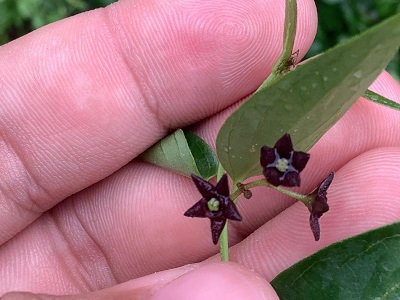The Lake Erie watershed is home to many sites of ecological importance. Unfortunately, countless invasive species of plants that threaten the ecological integrity of numerous habitats have also established themselves in the region. To identify and understand what invasive weeds could find their way to Erie, Brian Daggs, invasive plant ecologist at the Western Pennsylvania Conservancy, surveyed sites throughout 12 counties in Northwest Pennsylvania during the summer of 2021.
that threaten the ecological integrity of numerous habitats have also established themselves in the region. To identify and understand what invasive weeds could find their way to Erie, Brian Daggs, invasive plant ecologist at the Western Pennsylvania Conservancy, surveyed sites throughout 12 counties in Northwest Pennsylvania during the summer of 2021.
Focusing on aquatic, palustrine (fresh-water, vegetated wetlands) and riparian (near stream) habitats, Brian surveyed around points of disturbance at or near areas of ecological significance, logging the significant nonnative plants. “The overall goal was identifying the invasives within or near the Lake Erie watershed, early detection of invasive species and recognition of species that could potentially spread to the Erie watershed,” he says.
Brian surveyed sites in a roughly 100-mile radius from the Erie watershed, as far south as Butler county and as far east as Elk and McKean counties. Many survey areas comprised larger natural areas such as state parks and game lands. Using Survey123, a digital field data collection software, Brian recorded the searched areas and invasive species present in the areas. “That data were then uploaded to iMapInvasives.org, where anyone can get a registered account and view all the invasive species recorded throughout the summer,” Brian explains.
From June to October in 2021, Brian recorded about 1,400 invasive weed presences within 491 individual survey areas and 136 survey sites throughout Northwest Pennsylvania. Surveys covered a variety of habitats and areas, from state-owned public properties such as game lands and state parks, to local parks and private lands under conservation easements. About half of the surveyed areas were in Crawford and Erie counties, mostly in game lands that feature large wetland habitats, such as State Game Land 314 and State Game Land 213.
136 survey sites throughout Northwest Pennsylvania. Surveys covered a variety of habitats and areas, from state-owned public properties such as game lands and state parks, to local parks and private lands under conservation easements. About half of the surveyed areas were in Crawford and Erie counties, mostly in game lands that feature large wetland habitats, such as State Game Land 314 and State Game Land 213.
Along with updating records for the many well-known and long-established non-natives in the region, like bush honeysuckles, multiflora and Eurasian water-milfoil, the surveys revealed many significant range extensions and new arrivals in Northwest Pennsylvania. Among those are the fully aquatic brittle naiad (Najas minor), discovered in ponds and wetlands in Erie County, and the emergent wetland invader creeping water primrose (Ludwigia peploides var. glabrescens), found by a boat launch on the Allegheny River in Venango County. Other notable finds include mile-a-minute (Persicaria perfoliata), found in a disturbed floodplain of the Allegheny River in Venango County, and black swallow-wort (Vincetoxicum nigrum), found around the Pymatuning Reservoir in Crawford County.
Although invasive species were the focus of the project, Brian also encountered uncommon native plants like American bittersweet, hairy honeysuckle and northern blue flag, which have invasive species look-alikes.
The work did not end last summer after the survey, Brian says. “The survey efforts during 2021 pave the way to future invasive management efforts in Northwest Pennsylvania.” He points out that the many newly documented sites hosting brittle naiad are noteworthy targets for chemical and manual treatments to prevent further spread into the Erie watershed. Another high-priority removal target is the invasive Tree of Heaven, a host plant for another invasive species, the spotted lanternfly.
invasive management efforts in Northwest Pennsylvania.” He points out that the many newly documented sites hosting brittle naiad are noteworthy targets for chemical and manual treatments to prevent further spread into the Erie watershed. Another high-priority removal target is the invasive Tree of Heaven, a host plant for another invasive species, the spotted lanternfly.
Monitoring and managing invasive species is an ongoing struggle, and so efforts to survey and track invasive species are also ongoing, Brian notes. “The work last summer highlighted many areas where survey protocols could be improved, and identified properties and natural areas that could use a more detailed survey effort,” he says. “It becomes more pertinent that an effort is made to uncover and manage invasive species before they take hold in our highest quality habitats.”
The Western Pennsylvania Conservancy is a member of three of the four Cooperative Weed Management Areas (CWMAs) in Pennsylvania, including the Lake Erie Watershed CWMA. These partnerships bring together county, state and federal agencies, NGOs, businesses and landowners who are interested in raising awareness about invasive species and taking action to control their spread. Read more about the partnerships and our work.
###
About the Western Pennsylvania Conservancy
The Western Pennsylvania Conservancy (WPC) enhances the region by protecting and restoring exceptional places. A private nonprofit conservation organization founded in 1932, WPC has helped establish 11 state parks, conserved more than a quarter million acres of natural lands, protected or restored more than 3,000 miles of rivers and streams, and accessed hundreds of wildlife species and their habitats. The Conservancy owns and operates Frank Lloyd Wright’s Fallingwater, which is on the UNESCO World Heritage List and symbolizes people living in harmony with nature. In addition, WPC enriches our region’s cities and towns through 130 community gardens and other green spaces that are planted with the help of more than 5,000 volunteers. The work of the Western Pennsylvania Conservancy is accomplished through the support of more than 9,000 members. For more information, visit WaterLandLife.org or Fallingwater.org.
